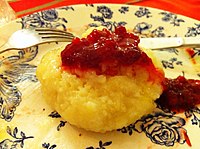
Porridge is a food made by heating or boiling ground, crushed or chopped starchy plants, typically grain, in milk or water. It is often cooked or served with added flavourings such as sugar, honey, (dried) fruit or syrup to make a sweet cereal, or it can be mixed with spices, meat or vegetables to make a savoury dish. It is usually served hot in a bowl, depending on its consistency. Oat porridge, or oatmeal, is one of the most common types of porridge. Gruel is a thinner version of porridge.
Knödel or Klöße are boiled dumplings commonly found in Central European and East European cuisine. Countries in which their variant of Knödel is popular include Austria, Germany, Hungary, Poland, Romania, Bosnia, Croatia, Serbia, Slovenia, Slovakia, Bulgaria and Czechia. They are also found in Scandinavian, Romanian, northeastern Italian cuisine, Ukrainian and Belarusian cuisines. Usually made from flour, bread or potatoes, they are often served as a side dish, but can also be a dessert such as plum dumplings, or even meat balls in soup. Many varieties and variations exist.

Finnish cuisine is notable for generally combining traditional country fare and haute cuisine with contemporary continental-style cooking. Fish and meat play a prominent role in traditional Finnish dishes in some parts of the country, while the dishes elsewhere have traditionally included various vegetables and mushrooms. Evacuees from Karelia contributed to foods in other parts of Finland in the aftermath of the Continuation War.

A blood sausage is a sausage filled with blood that is cooked or dried and mixed with a filler until it is thick enough to solidify when cooled. Most commonly, the blood of pigs, sheep, lamb, cow, chicken, or goose is used.

Kroppkaka is a traditional Swedish boiled potato dumpling, most commonly filled with onions and meat. Potatoes, wheat flour, onion, salt and minced meat/pork are common ingredients in kroppkaka. They are very similar to the Norwegian raspeball, Lithuanian cepelinai and German klöße. And quite similar to the Swedish palt.

Peasant foods are dishes eaten by peasants, made from accessible and inexpensive ingredients.
Blodpalt or is an old-fashioned dish still fairly common in northern Finland and parts of northern Sweden. The dish's history goes back to a time when the households carefully made use of all parts of the animals to get enough food.

Pitepalt is a Swedish dish related to kroppkakor or meat-filled dumplings. It is especially associated with the city of Piteå in Norrbotten County, thought to be its place of origin.

Czech cuisine has both influenced and been influenced by the cuisines of surrounding countries and nations. Many of the cakes and pastries that are popular in Central Europe originated within the Czech lands. Contemporary Czech cuisine is more meat-based than in previous periods; the current abundance of farmable meat has enriched its presence in regional cuisine. Traditionally, meat has been reserved for once-weekly consumption, typically on weekends.

Belarusian cuisine shares many similarities with cuisines of other Eastern, Central and Northeastern European countries, based predominantly on meat and various vegetables typical for the region.
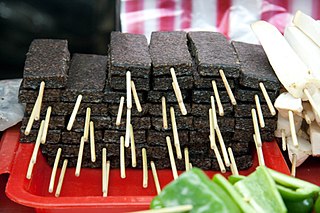
Many cultures consume blood, often in combination with meat. The blood may be in the form of blood sausage, as a thickener for sauces, a cured salted form for times of food scarcity, or in a blood soup. This is a product from domesticated animals, obtained at a place and time where the blood can run into a container and be swiftly consumed or processed. In many cultures, the animal is slaughtered. In some cultures, blood is a taboo food.
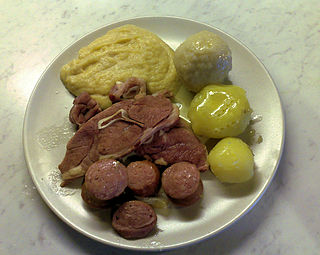
Potetball is a traditional Norwegian potato dumpling. A similar German dish is called Kartoffelklöße.
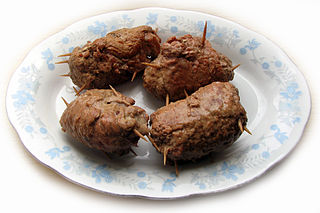
Silesian cuisine belongs to the region of Silesia in Central Europe. It is a subtype of Polish and German cuisine with many similarities to and signs of the influence of neighbouring cuisines. The cuisine is particularly renowned for its poppy seed and knödel dishes.
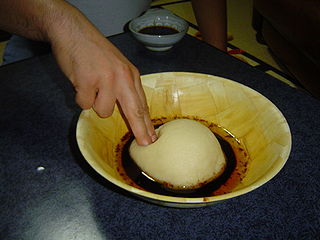
The cuisine of Libya is Arab and Mediterranean with Italian influence. One of the most popular Libyan dishes is bazin, an unleavened bread prepared with barley, water and salt. Bazin is prepared by boiling barley flour in water and then beating it to create a dough using a magraf, which is a unique stick designed for this purpose. Pork consumption is forbidden, in accordance with Sharia, the religious laws of Islam.

Dumpling is a broad class of dishes that consist of pieces of cooked dough, often wrapped around a filling. The dough can be based on bread, flour, buckwheat or potatoes, and it may be filled with meat, fish, tofu, cheese, vegetables, fruits or sweets. Dumplings may be prepared using a variety of cooking methods and are found in many world cuisines.

Möpkenbrot, also spelled as möppkenbrot, is a type of cooked German sausage prepared using pork, grain, apples and raisins. Its preparation is similar to that of blood sausage. The main ingredients are bacon, pig masks, pork rind, pork blood, and grated rye or wheat flour. The ingredients are formed into a dough, which is then boiled, after which it is typically sliced and pan-fried. It is similar in appearance to black pudding, but it is prepared using fruit, which imbues a fruity flavor, and it is also prepared using a greater amount of flour compared to black pudding.
